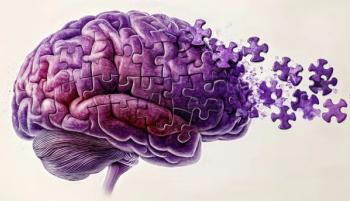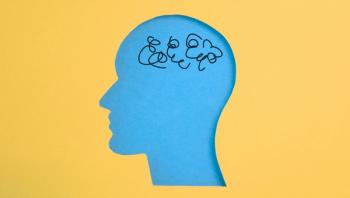
- Vol 38, Issue 3
- Volume 03
Early Warnings: Neuropsychiatric Manifestations of Huntington Disease
Neuropsychiatric manifestations of Huntington disease can present decades before the motor symptoms become apparent, making the role of the psychiatrist all the more important.
CLINICAL
First recognized in 1872 by George Huntington, MD,
Neuropathology of HD
The neuropathological hallmark among individuals with HD is the progressive atrophy of caudate nucleus and putamen due to neuronal loss.4 The clinical features of HD occur due to the loss of medium-sized projection spiny neurons in the dorsal striatum, which express the dopaminergic type 1 or 2 receptors. As the illness progresses, global neuronal loss and generalized cerebral atrophy occur, and the overall brain weight can decrease by up to 40%. These medium-sized projection spiny neurons use the inhibitory transmitter γ-aminobutyric acid and either dynorphin, enkephalin, or substance P as cotransmitters. It is thought that the loss of inhibitory input from the medium-sized spiny neurons, which usually exert an inhibitory effect, is the reason for the uncontrolled movements characteristic of individuals with HD. Individuals with HD also have intranuclear inclusions and protein aggregates in the dystrophic neurons of both the striatum and
Clinical Features of HD
There is significant variability in the type, timing, and progression of clinical symptoms.4 The clinical course can be divided into premanifest and
The symptoms of HD can be divided into 2 broad categories: progressive motor symptoms and neuropsychiatric symptoms.2 A diagnosis of HD is made only when the characteristic motor features manifest, even among individuals who are gene positive.
The motor symptoms of HD can be divided into 2 main categories: abnormal involuntary movements and impaired voluntary movements.1 Among individuals with HD, the most common abnormal movements are characteristic of chorea, which is among the early presenting symptoms, especially among individuals with adult-onset HD.
Manifestations
Neuropsychiatric symptoms are often present well before the motor symptoms manifest, sometimes decades prior, and include depression, irritability/aggression, executive dysfunction (eg, apathy, obsessive-compulsive behaviors), psychosis, cognitive decline, and dementia.1,7
Individuals with the HD gene who are presymptomatic exhibit a higher prevalence of neuropsychiatric symptoms.4 Neuropsychiatric complaints are the presenting symptom in approximately half of individuals. Among symptomatic individuals, more than 70% have neuropsychiatric symptoms, with symptoms often waxing and waning.
In a study of 1993 individuals with HD mutations from 15 European countries, 73% of the participants had some neuropsychiatric symptom within the past month.10 Moderate to severe apathy and depression were seen in 28.1% and 12.7% of the participants, respectively. Similarly, irritable and aggressive symptoms were present in 13.9% of the participants, and 13.2% of the participants showed obsessive/compulsive behaviors (OCBs). However, moderate to severe psychotic symptoms were found in only 1.2% of the participants. Apathy was more prevalent in advanced stages of the disease (11% in early stages vs 54.6% in advanced stages); it may be the only neuropsychiatric symptom that is linearly related to progressive neurodegeneration. Additionally, the presence of all neuropsychiatric symptoms during the previous month was associated with a positive psychiatric history, and a past episode of depression was particularly associated with
DEPRESSION. Depressed mood, loss of interest, guilt, and suicidality were more indicative of depression than somatic symptoms (eg, poor appetite, sleep disturbances, and psychomotor slowing).7 In patients with HD, depression is more common among women.10 Independent correlates of depression include a positive psychiatric history for
Suicidal ideation is also common in individuals with HD (
Examining the neuropsychiatric symptoms in a European HD cohort (REGISTRY) study, 24.7% of individuals with HD reported mild irritability/aggression, and 13.9% reported moderate to severe irritability/aggression.10 The prevalence of moderate to severe irritability and aggression increased as disease stage progressed, from 10.4% in the milder stages to 19.6% in the later stages. Independent correlates included male sex, younger age, history of depression, psychosis, and a previous suicide attempt.
OBSESSIVE-COMPULSIVE DISORDER. One review found the prevalence of OCBs ranged from 5% to 52%, whereas perseverative behaviors (PBs) occurred in approximately 75% of the individuals.12 Individuals with premanifest HD reported more OCBs when compared with gene-negative controls. However, individuals with manifest HD reported a higher rate of OCBs when compared with those with premanifest HD. Both OCBs and PBs are associated with duration and severity of HD, but they tend to decrease in the most advanced stage of the disease. A formal diagnosis of
PSYCHOSIS. A recent study of 7966 participants with manifest HD found that 12.95% had a history of psychosis.13 Only 2.83% of participants with premanifest HD had a history of psychosis. The mean age of psychosis onset was 48.34 years, and these individuals had mild-to-moderate psychosis. A family history of
ANXIETY DISORDERS. Available evidence indicates that between 13% and 71% of individuals may present with symptoms of anxiety.4
SLEEP DISORDERS. Approximately 90% of individuals report sleep problems, including insomnia, difficulties in falling asleep, frequent nocturnal awakenings, and excessive daytime sleepiness.15 Available evidence indicates that some sleep disorders are found in the early phase of the disease, even during the illness’ premanifest stage. These disorders may be associated with comorbid psychiatric disorders, especially mood and anxiety disorders. Involuntary movements and increased motor activity may also contribute to
COGNITION. Due to the degenerative nature of HD, individuals develop gradually progressive cognitive decline.7 Individuals develop the prototypical frontal-subcortical type of dementia, with frontal-executive disturbances, attentional deficits, and reductions in processing speed.16 These symptoms are the result of striatal and thalamic degeneration as well as degeneration in the caudate nucleus and putamen. As the illness progresses, abnormalities in visuomotor integration, visual perception, mental rotation, language production, and organization occur. However, the rate of progression of cognitive decline varies significantly among individuals, suggesting that other mechanisms (including environmental and genetic variables) may contribute to the neuropathological and clinical progression of cognitive decline.
Treatment
Available evidence indicates a comprehensive and multidisciplinary approach is required. Given the complexity of the illness’ clinical presentation, it should be treated by a group of providers including physicians, nurses, occupational and speech therapists, physical therapists, and social workers.9 Both nonpharmacological and pharmacological management strategies have benefited individuals with HD-associated neuropsychiatric symptoms.14 The use of nonpharmacological treatment strategies often complements pharmacological treatments. A thorough
There are no controlled trials for the pharmacotherapy of neuropsychiatric manifestations of HD, but evidence has been gathered from published case reports, case series, and an expert-based consensus guideline (
Concluding Thoughts
HD is a progressive and often fatal neurodegenerative disorder that is associated with severe motor and neuropsychiatric manifestations. The neuropsychiatric manifestations of HD can occur decades before the motor symptoms of HD become apparent, and they are associated with pathological changes that occur within the striatum and cortical regions of the brain, including the frontal lobes. Only apathy appears to be linearly related to the progressive neurodegeneration associated with HD. These manifestations are associated with significant disabilities and cause distress to both the individual with HD and their caregivers.
Currently, there are no disease-modifying strategies for the treatment of individuals with HD. Available treatment strategies focus on comprehensive multidisciplinary assessments and appropriate management of symptoms. There are no controlled studies for the treatment of neuropsychiatric manifestations of HD, but available evidence indicates efficacy for both nonpharmacological and pharmacological treatment modalities. The goal of treatment is to improve the quality of life for both the individual with HD and their caregivers.
Dr Tampi is professor and chairman, Department of Psychiatry & Behavioral Sciences, Cleveland Clinic Akron General, Akron, Ohio, and is the section chief for geriatric psychiatry, Cleveland Clinic, Cleveland, Ohio. Ms Weber is the manager of Behavioral Health Social Work, Cleveland Clinic Akron General, Akron, Ohio. Dr Masterson, is an attending psychiatrist, Department of Psychiatry & Behavioral Sciences, Cleveland Clinic Akron General, Akron, Ohio.
References
1. Stahl CM, Feigin A.
2. Dayalu P, Albin RL.
3. Bates GP, Dorsey R, Gusella JF, et al.
4. My Goh A, Wibawa P, Loi SM, et al.
5. Gil JM, Rego AC.
6. Ross CA, Aylward EH, Wild EJ, et al.
7. Teixeira AL, de Souza LC, Rocha NP, et al.
8. Videnovic A.
9. Loi SM, Walterfang M, Velakoulis D, Looi JC.
10. van Duijn E, Craufurd D, Hubers AAM, et al; European Huntington’s Disease Network Behavioural Phenotype Working Group.
11. Kachian ZR, Cohen-Zimerman S, Bega D, et al.
12. Oosterloo M, Craufurd D, Nijsten H, van Duijn E.
13. Jaini A, Yomtoob J, Yeh C, Bega D.
14. Anderson KE, van Duijn E, Craufurd D, et al.
15. Herzog-Krzywoszanska R, Krzywoszanski L.
16. Martinez-Horta S, Sampedro F, Horta-Barba A, et al.
17. Li Y, Hai S, Zhou Y, Rong Dong B.
Articles in this issue
almost 5 years ago
Cannabis 2021: What Clinicians Need to Knowalmost 5 years ago
The Age of Cannabis Has Arrived: Issues for Older Adultsalmost 5 years ago
Clinical Management of Cannabis Complicationsalmost 5 years ago
Exploring Psychiatry and the Human Condition: Joanna Moncrieff, MDalmost 5 years ago
Navigating New Challenges in the Management of ADHDalmost 5 years ago
Swift Action: A Look at President Biden’s Health Care Executive Ordersalmost 5 years ago
Is There a Link Between Exercise, Cognition, and Schizophreniaalmost 5 years ago
Whose Turn Should It Be? The Ethics of COVID-19 Vaccine Allocationalmost 5 years ago
Does Cannabis Cause Psychosis?Newsletter
Receive trusted psychiatric news, expert analysis, and clinical insights — subscribe today to support your practice and your patients.

















